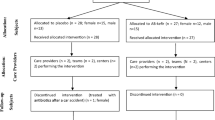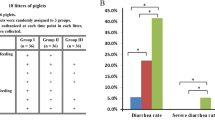Abstract
Functional foods containing probiotics are generally administered as dairy products. Non-dairy beverages are another possibility, but probiotic functionality must be confirmed in such vehicles. In the present study, a craft wheat beer brewed with the probiotic yeast Saccharomyces cerevisiae UFMG A-905 (905) was evaluated in a murine model of Salmonella Typhimurium infection. Unfiltered or filtered beer brewed with 905, a commercial wheat beer used as a negative control, or saline were administered orally to mice before and during oral S. Typhimurium challenge. High fecal levels of yeast were only counted in mice treated with the unfiltered 905 beer, which also had reduced mortality and body weight loss due to S. Typhimurium infection. Increased levels of intestinal IgA, translocation to liver and spleen, liver and intestinal lesions, pro-inflammatory cytokines in liver and ileum, and hepatic and intestinal myeloperoxidase and eosinophilic peroxidase activities were observed in animals infected with S. Typhimurium. All these parameters were reduced by the treatment with unfiltered 905 beer. In conclusion, the results show that a craft wheat beer brewed with S. cerevisiae UFMG A-905 maintained the probiotic properties of this yeast when administered orally to mice challenged with S. Typhimurium.









Similar content being viewed by others
Data Availability
The datasets generated during the current study are available from the current author on request.
References
Food and Agriculture Organization of the United Nations/World Health Organization FAO/WHO (2002) Guidelines for the evaluation of probiotics in food. Joint FAO/WHO Working Group, London, Ontario, Canada. Available online: http://www.who.int/foodsafety/fs_management/en/probiotic_guidelines.pdf. Accessed 01 Feb 2020
Lazo-Vélez MA, Serna-Saldívar SO, Rosales-Medina MF, Tinoco-Alvear M, Briones-García M (2018) Application of Saccharomyces cerevisiae var. boulardii in food processing: a review. J Appl Microbiol 125:943–951. https://doi.org/10.1111/jam.14037
Rodhouse L, Carbonero F (2017) Overview of craft brewing specificities and potentially associated microbiota. Crit Rev Food Sci Nutr 14:1–12. https://doi.org/10.1080/10408398.2017.1378616
Capece A, Romaniello R, Pietrafesa A, Siesto G, Pietrafesa R, Zambuto M, Romano P (2018) Use of Saccharomyces cerevisiae var. boulardii in co-fermentations with S. cerevisiae for the production of craft beers with potential healthy value-added. Int J Food Microbiol 284:22–30. https://doi.org/10.1016/j.ijfoodmicro.2018.06.028
Mulero-Cerezo J, Briz-Redón Á, Serrano-Aroca Á (2019) Saccharomyces cerevisiae var. boulardii: valuable probiotic starter for craft beer production. Appl Sci 9:3250. https://doi.org/10.3390/app9163250
Silva LC, Schmidt GB, Alves LGO, Oliveira VS, Laureano-Melo R, Stutz EVG, Martins JFP, Paula BP, Paula BP, Luchese RH, Guerra AF, Rodrigues P (2020) Use of probiotic strains to produce beers by axenic or semi-separated co-culture system. Food Bioprod Process 124:408–418. https://doi.org/10.1016/j.fbp.2020.10.001
Silva LC, Souza Lago H, Rocha MOT, Oliveira VS, Laureano-Melo R, Stutz EVG, Paula BP, Martins JFP, Luchese RH, Guerra AF, Rodrigues P (2021) Craft beers fermented by potential probiotic yeast or Lacticaseibacilli strains promote antidepressant-like behavior in Swiss Webster mice. Probiotics Antimicrob Prot 13:698–708. https://doi.org/10.1007/s12602-020-09736-6
Zheng J, Wittouck S, Salvetti E, Franz CMAP, Harris HMB, Mattarelli P, O’Toole PW, Pot B, Vandamme P, Walter J, Watanabe K, Wuyts S, Felis GE, Gänzle MG, Lebeer S (2020) A taxonomic note on the genus Lactobacillus: description of 23 novel genera, emended description of the genus Lactobacillus Beijerinck 1901, and union of Lactobacillaceae and Leuconostocaceae. Int J Syst Evol Microbiol 70:2782–2858. https://doi.org/10.1099/ijsem.0.004107
Chan MZA, Chua JY, Toh M, Liu SQ (2019) Survival of probiotic strain Lactobacillus paracasei L26 during co-fermentation with S. cerevisiae for the development of a novel beer beverage. Food Microbiol 82:541–550. https://doi.org/10.1016/j.fm.2019.04.001
Martins FS, Nardi RMD, Arantes RME, Rosa CA, Neves MJ, Nicoli JR (2005) Screening of yeasts as probiotic based on capacities to colonize the gastrointestinal tract and to protect against enteropathogen challenge in mice. J Gen Appl Microbiol 51:83–92. https://doi.org/10.2323/jgam.51.83
Martins FS, Rodrigues ACP, Tiago FCP, Penna FJ, Rosa CA, Arantes RME, Nardi RMD, Neves MJ, Nicoli JR (2007) Saccharomyces cerevisiae strain 905 reduces the translocation of Salmonella enterica serotype Typhimurium and stimulates the immune system in gnotobiotic and conventional mice. J Med Microbiol 56:352–359. https://doi.org/10.1099/jmm.0.46525-0
Generoso SV, Viana MV, Santos R, Martins FS, Machado JAN, Arantes RME, Nicoli JR, Correia MITD, Cardoso VN (2010) Saccharomyces cerevisiae strain UFMG 905 protects against bacterial translocation, preserves gut barrier integrity and stimulates the immune system in a murine intestinal obstruction model. Arch Microbiol 192:477–484. https://doi.org/10.1007/s00203-010-0574-8
Martins FS, Andrade SDE, Vieira AT, Tiago FCP, Martins AKS, Silva FCP, Souza ELS, Sousa LP, Araujo HRC, Pimenta PF, Bonjardim CA, Arantes RME, Teixeira MM, Nicoli JR (2011) Oral treatment with Saccharomyces cerevisiae strain UFMG 905 modulates immune responses and interferes with signal pathways involved in the activation of inflammation in a murine model of typhoid fever. Int J Med Microbiol 301:359–364. https://doi.org/10.1016/j.ijmm.2010.11.002
Tiago FCP, Martins FS, Souza ELS, Pimenta PFP, Araujo HRC, Castro IM, Brandão RL, Nicoli JR (2012) Adhesion to the yeast cell surface as mechanism for trapping pathogenic bacteria by Saccharomyces probiotics. J Med Microbiol 61:1194–1207. https://doi.org/10.1099/jmm.0.042283-0
Tiago FCP, Ribeiro NS, Moreira LMC, Arantes RME, Vieira AT, Teixeira MM, Martins FS, Nicoli JR (2015) Effect of Saccharomyces cerevisiae strain UFMG A-905 in experimental animal model of inflammatory bowel disease. Benef Microb 6:807–815. https://doi.org/10.3920/BM2015.0018
Bastos RW, Pedroso SHSP, Vieira AT, Moreira LMC, França CS, Cartelle CT, Arantes RME, Generoso SV, Cardoso VN, Neves MJ, Nicoli JR, Martins FS (2016) Saccharomyces cerevisiae UFMG A-905 reduces intestinal damage in irinotecan-induced mucositis. Benef Microb 7:549–557. https://doi.org/10.3920/BM2015.0190
Porto BAA, Monteiro CF, Souza ÉLS, Leocádio PCL, Alvarez-Leite JI, Generoso SV, Cardoso VN, Almeida-Leite CM, Santos DA, Santos JRA, Nicoli JR, Pessione E, Martins FS (2019) Treatment with selenium-enriched Saccharomyces cerevisiae UFMG A-905 partially ameliorates mucositis induced by 5-fluorouracil in mice. Cancer Chemother Pharmacol 84:117–126. https://doi.org/10.1007/s00280-019-03865-8
Fonseca VMB, Milani TMS, Prado R, Bonato VLD, Ramos SG, Martins FS, Vianna EO, Borges MC (2017) Oral administration of Saccharomyces cerevisiae UFMG A-905 prevents allergic asthma in mice. Respirology 22:905–912. https://doi.org/10.1111/resp.12990
Miranda VC, Santos SS, Assis HC, Faria AMC, Quintanilha MF, Morão RP, Nicoli JR, Cara DC, Martins FS (2020) Effect of Saccharomyces cerevisiae UFMG A-905 in a murine model of food allergy. Benef Microb 11:255–268. https://doi.org/10.3920/BM2019.0113
Ciriello CJ, Lachance MA (2001) YEASTCOMPARE. University of Western Ontario, London, ON, Canada
Souza DG, Vieira AT, Soares AC, Pinho V, Nicoli JR, Vieira LQ, Teixeira MM (2004) The essential role of the intestinal microbiota in facilitating acute inflammatory responses. J Immunol 173:4137–4146. https://doi.org/10.1016/j.ijmm.2010.11.002
Sanders ME, Klaenhammer TR, Ouwehand AC, Pot B, Johansen E, Heimbach JT, Marco ML, Tennilä J, Ross RP, Franz C, Pagé N, Pridmore RD, Leyer G, Salminen S, Charbonneau D, Call E, Lenoir-Wijnkoop I (2014) Effects of genetic, processing, or product formulation changes on efficacy and safety of probiotics. Ann N Y Acad Sci 1309:1–18. https://doi.org/10.1111/nyas.12363
Zacarías MF, Souza TC, Zaburlín N, Cara DC, Reinheimer J, Nicoli JR, Vinderola G (2017) Influence of technological treatments on the functionality of Bifidobacterium lactis INL1, a breast milk-derived probiotic. J Food Sci 82:2462–2470. https://doi.org/10.1111/1750-3841.13852
Tsolis RM, Xavier MN, Santos RL, Baumler AJ (2011) How to become a top model: impact of animal experimentation on human Salmonella disease research. Infect Immun 79:1806–1814. https://doi.org/10.1128/IAI.01369-10
LaRock DL, Chaudhary A, Miller SI (2015) Salmonellae interactions with host processes. Nat Rev Microbiol 13:191–205. https://doi.org/10.1038/nrmicro3420
Martins FS, Nicoli JR (2015) Mechanisms of action of probiotic yeasts. Probiotics and prebiotics: current research and future trends. Venema K, Carmo AP (Eds.), Caister Academic Press, Horizonte Press, Poole, UK, Cap.7, 560 pp. ISBN: 978–1–910190–09–8
Salminen S, Collado MC, Endo A, Hill C, Lebeer S, Quigley EMM, Sanders ME, Shamir R, Swann JR, Szajewska H, Vinderola G (2021) The International Scientific Association of Probiotics and Prebiotics (ISAPP) consensus statement on the definition and scope of postbiotics. Nat Rev Gastroenterol Hepatol 18:649–667. https://doi.org/10.1038/s41575-021-00440-6
Sougioultzis S, Simeonidis S, Bhaskar KR, Chen X, Anton PM, Keates S, Pothoulakis C, Kelly CP (2006) Saccharomyces boulardii produces a soluble anti-inflammatory factor that inhibits NF-kβ mediated IL-8 gene expression. Biochem Biophys Res Commun 343:69–76. https://pubmed.ncbi.nlm.nih.gov/16529714/
Fransen F, Zagato E, Mazzini E, Fosso B, Manzari C, El Aidy S, Chiavelli A, D’Erchia AM, Sethi MK, Pabst O, Marzano M, Moretti S, Romani L, Penna G, Pesole G, Rescigno M (2015) BALB/c and C57BL/6 mice differ in polyreactive IgA abundance, which impacts the generation of antigen-specific IgA and microbiota diversity. Immunity 43:527–540. https://doi.org/10.1016/j.immuni.2015.08.011
Gaetano G, Costanzo S, Castelnuovo A, Badimon L, Bejko D, Alkerwi A, Chiva-Blanch G, Estruch R, La Vecchia C, Panico S, Pounis G, Sofi F, Stranges S, Trevisan M, Ursini F, Cerletti C, Donati MB, Iacoviello L (2016) Effects of moderate beer consumption on health and disease: a consensus document. Nutr Metab Cardiovasc Dis 26:443–467. https://doi.org/10.1016/j.numecd.2016.03.007
O’Keefe EL, Di Nicolantonio JJ, O’Keefe JH, Lavie CJ (2018) Alcohol and cardiovascular health: Jekyll and Hyde J-Curves. Prog Cardiovasc Dis 61:68–75. https://doi.org/10.1016/j.pcad.2018.02.001
Humia BV, Santos KS, Barbosa AM, Sawata M, Mendonça MC, Padilha FF (2019) Beer molecules and its sensory and biological properties: a review. Molecules 24:1568. https://doi.org/10.3390/molecules24081568
Huang S, Li J, Shearer GC, Lichtenstein AH, Zheng X, Wu Y, Jin C, Wu S, Gao X (2017) Longitudinal study of alcohol consumption and HDL concentrations: a community-based study. Am J Clin Nutr 105:905–912. https://doi.org/10.3945/ajcn.116.144832
Nova E, Mauro-Martín IS, Díaz-Prieto LE, Marcos A (2019) Wine and beer within a moderate alcohol intake is associated with higher levels of HDL-c and adiponectin. Nutr Res 63:42–50. https://doi.org/10.1016/j.nutres.2018.12.007
Padro T, Muñoz-García N, Vilahur G, Chagas P, Deyá A, Antonijoan RM, Badimon L (2018) Moderate beer intake and cardiovascular health in overweight individuals. Nutrients 10:1237. https://doi.org/10.3390/nu10091237
Quesada-Molina M, Muñoz-Garach A, Tinahones FJ, Moreno-Indias I (2019) A new perspective on the health benefits of moderate beer consumption: involvement of the gut microbiota. Metabolites 9:272. https://doi.org/10.3390/metabo9110272
González-Zancada N, Redondo-Useros N, Díaz LE, Gómez-Martínez S, Marcos A, Nova E (2020) Association of moderate beer consumption with the gut microbiota and SCFA of healthy adults. Molecules 25:4772. https://doi.org/10.3390/molecules25204772
Funding
This study was supported by grants from Conselho Nacional de Desenvolvimento Científico e Tecnológico (CNPq) and Fundação de Amparo a Pesquisa de Minas Gerais (FAPEMIG). SRM Oliveira was a doctoral fellow at the Fundação de Amparo da Pesquisa do Estado da Bahia (FAPESB).
Author information
Authors and Affiliations
Contributions
SRMO, APTU, FSM and JRN conceived and designed the experiments; SRMO, LLC, MNSA, BG, ROS, MFR, KDV, SOAF, MSJ and AMS performed the experiments; SRMO, APTU, MFR, KDV, SOAF, MSJ, AMS, FSM and JRN analyzed the data; VNC and SOAF contributed data or analysis tools; and JRN wrote the paper.
Corresponding author
Ethics declarations
Disclaimer
The funders had no role in study design, data collection and analysis, decision to publish, or preparation of the manuscript.
Research Involving Human and Animal Participants
All experimental procedures were performed in accordance with the norms of the Brazilian Society of Animal Science/Brazilian College of Animal Experimentation (available at http://www.mctic.gov.br/concea) and approved by the Ethics Committee in Animal Experimentation of the Universidade Federal de Minas Gerais (Protocol No 196/2019, CEUA/UFMG).
Conflict of Interest
The authors declare no competing interests.
Additional information
Publisher's Note
Springer Nature remains neutral with regard to jurisdictional claims in published maps and institutional affiliations.
Rights and permissions
Springer Nature or its licensor holds exclusive rights to this article under a publishing agreement with the author(s) or other rightsholder(s); author self-archiving of the accepted manuscript version of this article is solely governed by the terms of such publishing agreement and applicable law.
About this article
Cite this article
Oliveira, S.R.M., Campos, L.L., Amaral, M.N.S. et al. Evaluation of a Functional Craft Wheat Beer Fermented with Saccharomyces cerevisiae UFMG A-905 to treat Salmonella Typhimurium infection in mice. Probiotics & Antimicro. Prot. 15, 1180–1192 (2023). https://doi.org/10.1007/s12602-022-09973-x
Accepted:
Published:
Issue Date:
DOI: https://doi.org/10.1007/s12602-022-09973-x




